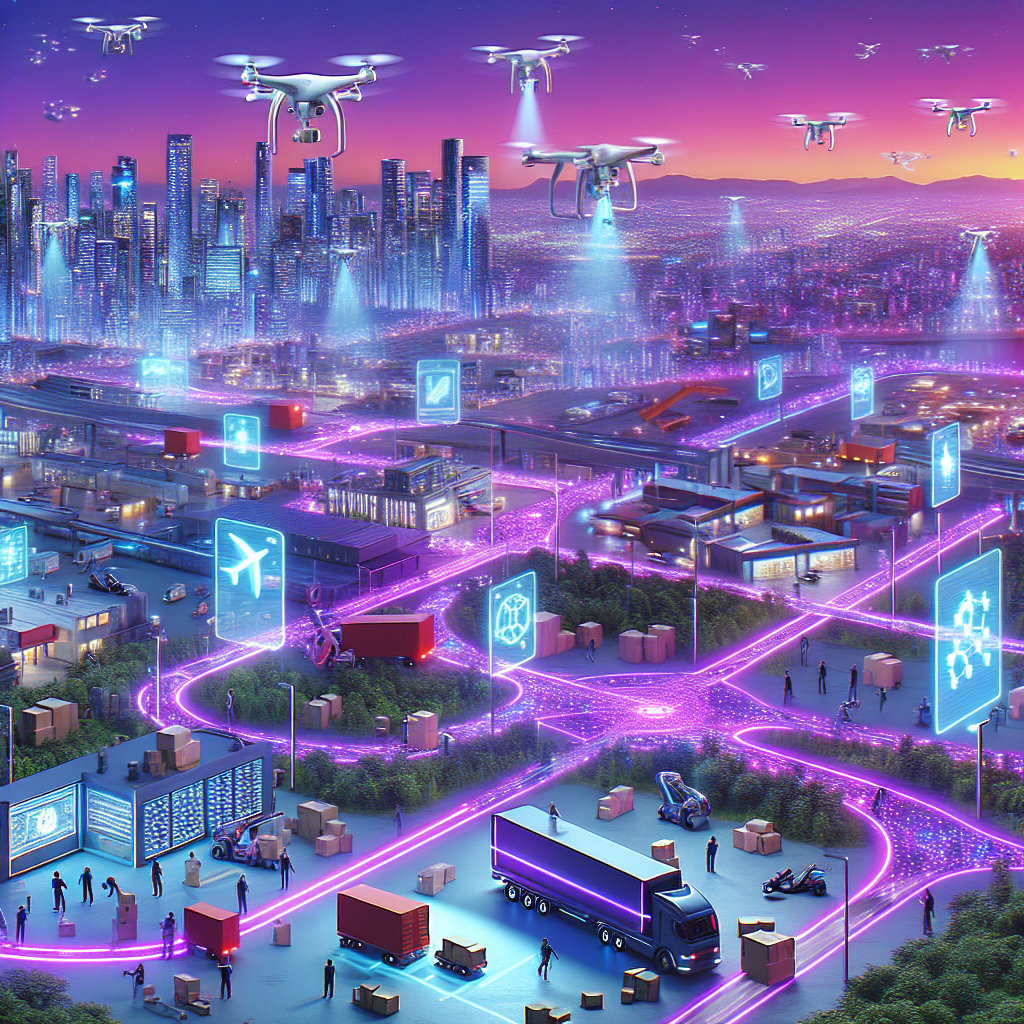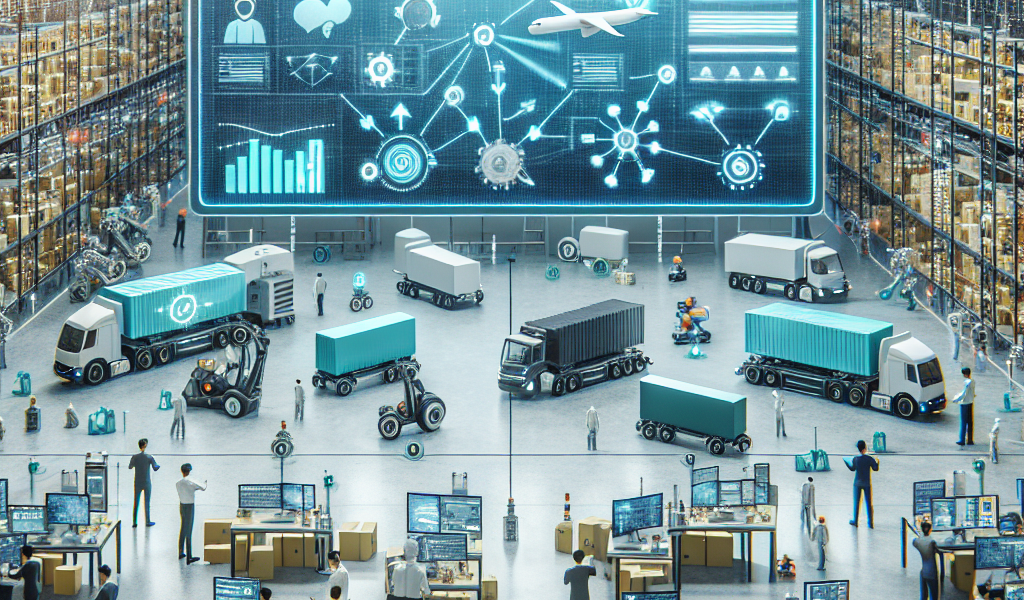-
Table of Contents
“Revolutionizing Efficiency: The Future of Smart Logistics”
Introduction

The Future of Smart Logistics
The future of smart logistics is poised to revolutionize the way goods are transported, stored, and managed across the globe. Leveraging cutting-edge technologies such as artificial intelligence, the Internet of Things (IoT), blockchain, and advanced data analytics, smart logistics aims to create highly efficient, transparent, and responsive supply chains. These innovations promise to enhance operational efficiency, reduce costs, and improve customer satisfaction by enabling real-time tracking, predictive maintenance, and automated decision-making. As industries continue to embrace digital transformation, smart logistics will play a crucial role in driving economic growth, sustainability, and resilience in an increasingly interconnected world.
The Role Of Artificial Intelligence In Smart Logistics
The future of smart logistics is being shaped by the rapid advancements in artificial intelligence (AI), which is revolutionizing the way goods are transported, stored, and delivered. As companies strive to meet the growing demands of consumers for faster and more efficient services, AI is emerging as a critical tool in optimizing logistics operations. This transformation is not only enhancing the efficiency of supply chains but also reducing costs and improving customer satisfaction.
One of the most significant ways AI is impacting smart logistics is through predictive analytics. By analyzing vast amounts of data from various sources, AI algorithms can forecast demand with remarkable accuracy. This allows companies to better manage their inventory levels, ensuring that products are available when and where they are needed. For instance, retailers can use AI to predict which items will be popular during certain seasons or events, enabling them to stock up accordingly and avoid the pitfalls of overstocking or stockouts.
In addition to demand forecasting, AI is also playing a crucial role in route optimization. Traditional methods of planning delivery routes often rely on static data and can be inefficient. However, AI-powered systems can analyze real-time traffic conditions, weather patterns, and other variables to determine the most efficient routes for delivery vehicles. This not only reduces fuel consumption and delivery times but also minimizes the environmental impact of logistics operations.
Moreover, AI is enhancing warehouse management through the use of autonomous robots and smart systems. These technologies can perform tasks such as picking, packing, and sorting with greater speed and accuracy than human workers. By automating these processes, companies can significantly reduce labor costs and improve the overall efficiency of their warehouses. Additionally, AI-powered systems can monitor the condition of goods in real-time, ensuring that perishable items are stored at the correct temperatures and alerting managers to any potential issues before they become critical.
Another area where AI is making a substantial impact is in the realm of last-mile delivery. This final leg of the delivery process is often the most challenging and expensive, as it involves getting products directly to consumers’ doorsteps. AI-driven solutions, such as delivery drones and autonomous vehicles, are being developed to address these challenges. These technologies have the potential to drastically reduce delivery times and costs, while also providing a more convenient and reliable service for customers.
Furthermore, AI is facilitating better decision-making through advanced data analytics and machine learning. By processing and analyzing data from various sources, AI can identify patterns and trends that may not be immediately apparent to human analysts. This enables logistics companies to make more informed decisions about everything from inventory management to transportation strategies. For example, AI can help identify inefficiencies in the supply chain and suggest improvements, leading to more streamlined operations and cost savings.
As AI continues to evolve, its role in smart logistics is likely to expand even further. The integration of AI with other emerging technologies, such as the Internet of Things (IoT) and blockchain, promises to create even more sophisticated and efficient logistics systems. IoT devices can provide real-time data on the location and condition of goods, while blockchain can ensure the security and transparency of transactions. Together with AI, these technologies have the potential to create a truly interconnected and intelligent logistics network.
In conclusion, the role of artificial intelligence in smart logistics is becoming increasingly vital as companies seek to enhance their operations and meet the demands of a rapidly changing market. Through predictive analytics, route optimization, warehouse automation, last-mile delivery innovations, and advanced data analytics, AI is transforming the logistics industry. As these technologies continue to develop, the future of smart logistics looks brighter than ever, promising greater efficiency, cost savings, and improved customer experiences.
How Autonomous Vehicles Are Revolutionizing Supply Chain Management
The future of smart logistics is being shaped by the rapid advancements in autonomous vehicle technology, which is revolutionizing supply chain management in ways previously unimaginable. As companies strive to meet the growing demands of e-commerce and consumer expectations for faster delivery times, the integration of autonomous vehicles into logistics operations is becoming increasingly essential. This transformation is not only enhancing efficiency but also paving the way for a more sustainable and resilient supply chain.
One of the most significant impacts of autonomous vehicles on supply chain management is the potential for increased efficiency. Traditional logistics operations often face challenges such as driver shortages, human error, and regulatory constraints. Autonomous vehicles, however, can operate around the clock without the need for rest breaks, thereby significantly reducing delivery times. Moreover, these vehicles are equipped with advanced sensors and artificial intelligence systems that enable them to navigate complex routes with precision, minimizing the risk of accidents and delays.
In addition to improving efficiency, autonomous vehicles are also contributing to cost savings in the supply chain. The reduction in labor costs is one of the most obvious benefits, as companies can rely on self-driving trucks and delivery robots to perform tasks that would otherwise require human intervention. Furthermore, autonomous vehicles are designed to optimize fuel consumption and reduce wear and tear on the vehicle, leading to lower maintenance and operational costs. These savings can be passed on to consumers in the form of lower prices, making goods more affordable and accessible.
Another critical advantage of autonomous vehicles in supply chain management is their ability to enhance sustainability. With growing concerns about climate change and environmental impact, companies are under increasing pressure to adopt greener practices. Autonomous vehicles, particularly electric and hybrid models, produce fewer emissions compared to traditional diesel-powered trucks. Additionally, their ability to optimize routes and reduce idle times further contributes to a decrease in carbon footprint. As a result, the adoption of autonomous vehicles aligns with corporate sustainability goals and regulatory requirements, promoting a more eco-friendly supply chain.
The integration of autonomous vehicles into supply chain management also offers greater flexibility and resilience. In times of crisis, such as natural disasters or pandemics, the ability to maintain uninterrupted logistics operations is crucial. Autonomous vehicles can be deployed in hazardous conditions where it may be unsafe for human drivers, ensuring the continuous flow of goods. Moreover, their advanced data analytics capabilities allow for real-time monitoring and decision-making, enabling companies to quickly adapt to changing circumstances and mitigate potential disruptions.
Despite the numerous benefits, the widespread adoption of autonomous vehicles in supply chain management is not without challenges. Regulatory hurdles, technological limitations, and public perception are some of the obstacles that need to be addressed. Governments and industry stakeholders must collaborate to establish clear guidelines and standards for the safe and ethical use of autonomous vehicles. Additionally, ongoing research and development are necessary to overcome technical barriers and enhance the reliability of these systems.
In conclusion, autonomous vehicles are poised to revolutionize supply chain management by improving efficiency, reducing costs, enhancing sustainability, and increasing resilience. As technology continues to advance and regulatory frameworks evolve, the integration of autonomous vehicles into logistics operations will become more prevalent. Companies that embrace this innovation will be better positioned to meet the demands of the modern marketplace and drive the future of smart logistics.
The Impact Of IoT On The Future Of Smart Warehousing
The future of smart logistics is being shaped by the rapid advancements in technology, and one of the most transformative elements is the Internet of Things (IoT). As we delve into the impact of IoT on the future of smart warehousing, it becomes evident that this technology is revolutionizing the way warehouses operate, making them more efficient, responsive, and intelligent.
To begin with, IoT enables real-time tracking and monitoring of goods within the warehouse. Sensors and RFID tags attached to products provide continuous updates on their location, condition, and status. This real-time visibility not only enhances inventory management but also reduces the likelihood of misplaced or lost items. Consequently, warehouse managers can make more informed decisions, streamline operations, and ensure that products are always available when needed.
Moreover, IoT facilitates predictive maintenance of warehouse equipment. By collecting and analyzing data from various sensors embedded in machinery, IoT systems can predict when a piece of equipment is likely to fail or require maintenance. This proactive approach minimizes downtime, reduces repair costs, and extends the lifespan of the equipment. As a result, warehouses can maintain a higher level of operational efficiency and avoid unexpected disruptions.
In addition to improving equipment maintenance, IoT also enhances the safety and security of warehouses. Smart sensors can detect potential hazards such as fire, gas leaks, or unauthorized access, and immediately alert the relevant personnel. This early warning system allows for swift action to mitigate risks and protect both the workforce and the inventory. Furthermore, IoT-enabled surveillance systems provide continuous monitoring of the warehouse premises, deterring theft and ensuring that any security breaches are promptly addressed.
Another significant impact of IoT on smart warehousing is the optimization of energy consumption. IoT devices can monitor and control lighting, heating, and cooling systems based on real-time data and usage patterns. By optimizing energy usage, warehouses can reduce their carbon footprint and achieve substantial cost savings. This not only benefits the environment but also contributes to the overall sustainability goals of the organization.
Additionally, IoT plays a crucial role in enhancing the efficiency of warehouse operations through automation. Autonomous robots and drones, guided by IoT technology, can perform tasks such as picking, packing, and transporting goods with precision and speed. This automation reduces the reliance on manual labor, minimizes human error, and accelerates the fulfillment process. Consequently, warehouses can handle larger volumes of goods and meet the growing demands of e-commerce and other industries.
Furthermore, IoT enables seamless integration with other technologies such as artificial intelligence (AI) and big data analytics. By combining IoT data with AI algorithms, warehouses can gain deeper insights into their operations and identify areas for improvement. For instance, AI can analyze historical data to forecast demand, optimize inventory levels, and enhance supply chain planning. This data-driven approach ensures that warehouses are always prepared to meet customer demands and adapt to changing market conditions.
In conclusion, the impact of IoT on the future of smart warehousing is profound and far-reaching. From real-time tracking and predictive maintenance to enhanced safety, energy optimization, automation, and data-driven insights, IoT is transforming warehouses into intelligent, efficient, and responsive hubs. As technology continues to evolve, the potential for further advancements in smart logistics is limitless, promising a future where warehouses operate seamlessly and efficiently to meet the ever-growing demands of the global market.
Conclusion
The future of smart logistics is poised to revolutionize supply chain management through the integration of advanced technologies such as artificial intelligence, the Internet of Things (IoT), blockchain, and autonomous vehicles. These innovations promise to enhance efficiency, transparency, and responsiveness, enabling real-time tracking, predictive analytics, and automated decision-making. As a result, businesses can expect reduced operational costs, improved customer satisfaction, and greater adaptability to market changes. However, the successful implementation of smart logistics will require significant investment in infrastructure, cybersecurity, and workforce training to fully realize its potential benefits.





